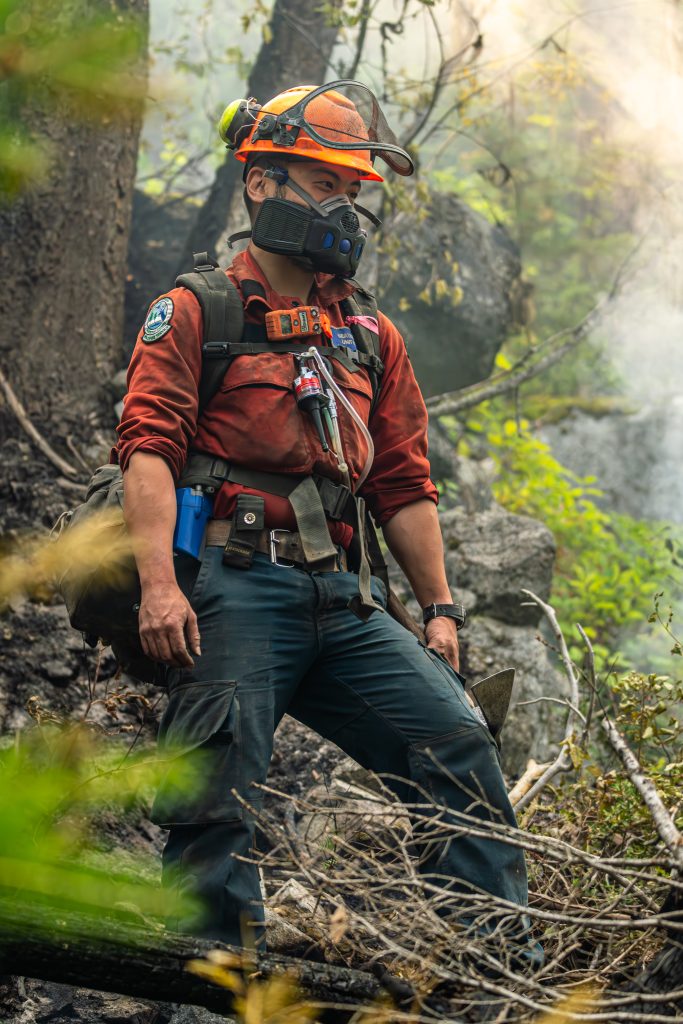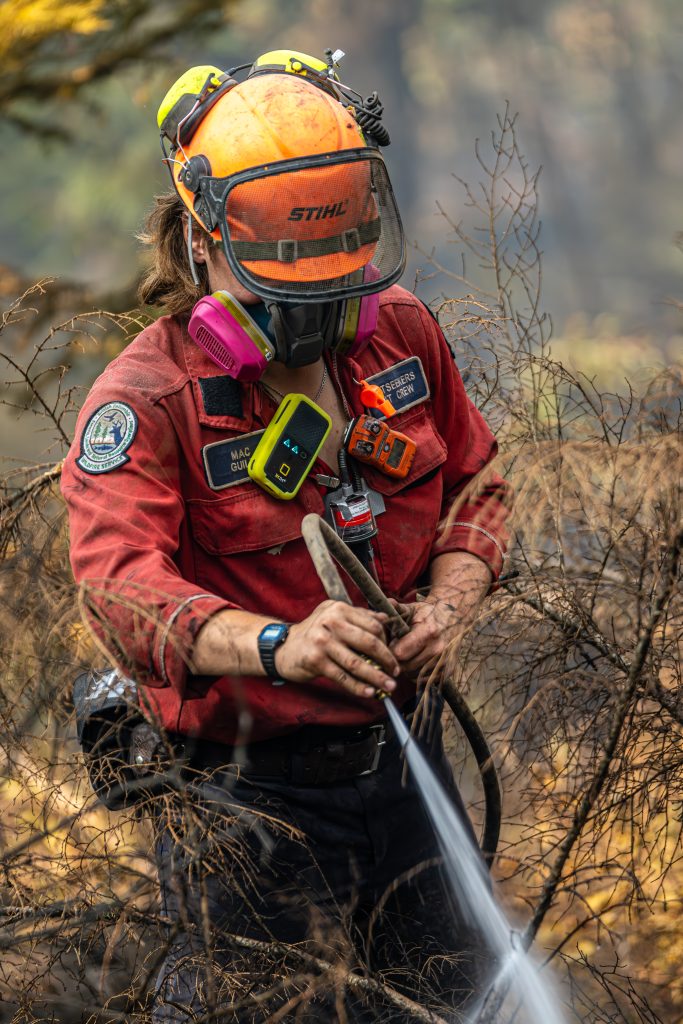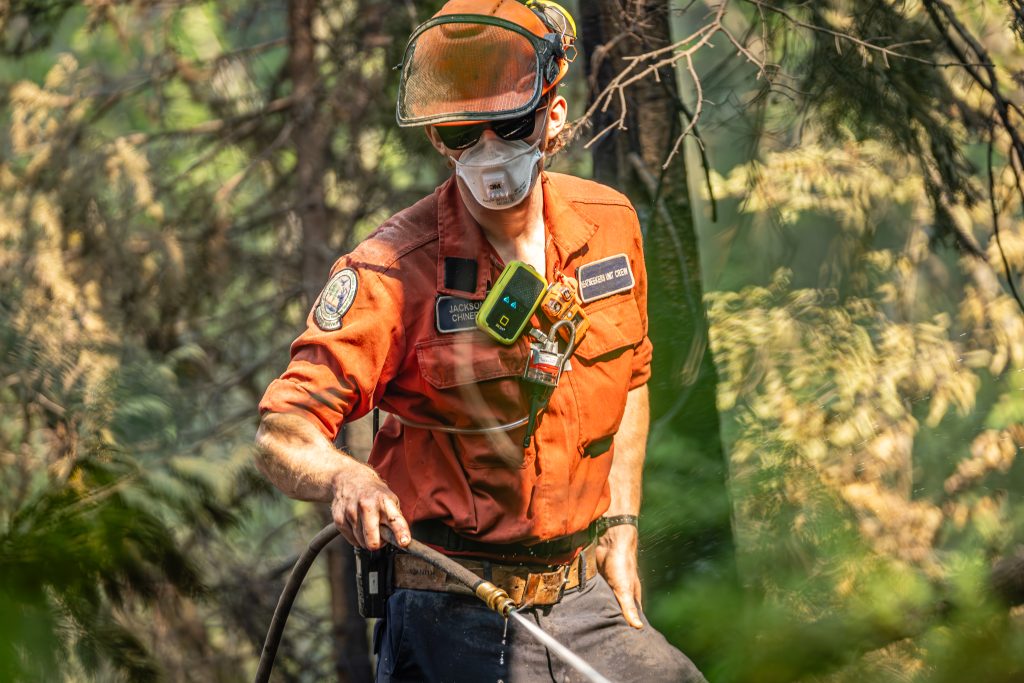Wildland firefighters have historically used bandanas or cloth masks as their own form of respiratory protection on the fire line. However, these offer little to no protection against the incredibly small particulates in wildfire smoke, which easily bypass gaps in the simple cloth material. Additionally, these styles of face coverings do not protect against any of the hazardous gases present in wildfire smoke. Exposure to these hazards is a serious concern and has been a major area of research for our organization.
We have worked directly with occupational hygienists, safety and wellness staff and researchers to develop foundational knowledge regarding respiratory hazards and their associated health effects, both on the fire line and at fire camp. With the culmination of this foundational research, we have identified respiratory protection that can help minimize exposure to wildfire smoke, ash, dust and engine exhaust.
Respiratory protection certified by the National Institute for Occupational Safety and Health (NIOSH) was made available to all operational staff during the 2024 wildfire season. We are excited to be a leader among wildland fire agencies by offering high quality, NIOSH certified respiratory protection on a non-mandatory, opt-in basis at this scale.
Exposure to respiratory hazards on the fire line
Research has shown that staff on fire lines are exposed to carcinogenic compounds present in wildfire smoke, ash, dust and engine exhaust.
The major concerns found in wildfire smoke, ash, dust and engine exhaust include:
- Fine particulate matter (PM2.5) – small particles that are invisible to the human eye. When inhaled, these can cause inflammation and oxidative stress in the lungs and other organs in the body. Chronic exposure increases the risk of developing lung disease, including cancer, and cardiovascular disease.
- Carbon monoxide (CO) – an invisible, odourless gas that, when inhaled, displaces oxygen in the blood. This can cause headache, nausea, confusion, dizziness and, at extreme levels, may result in collapse and even death.
- Formaldehyde – a colourless, carcinogenic gas. Exposure can cause eye and throat irritation and increase the risk of developing upper respiratory tract cancer and leukemia.
- Benzene – a colourless, carcinogenic gas. Exposure increases the risk of developing adverse health effects, including leukemia.
- Polycyclic aromatic hydrocarbons (PAHs) – gases and small particles that can be inhaled or absorbed through the skin. Chronic exposure is associated with an increased risk of lung, skin and bladder cancers.
- Crystalline silica – a naturally occurring mineral in soil that can be made airborne and inhaled. Chronic exposure may cause lung cancer, as well as a lung disease called Silicosis.
Respiratory protection
We introduced three respiratory protection models for the 2024 wildfire season, which staff can choose from based on their individual preferences: two elastomeric dual-cartridge style respirators and a N95 respirator.
The selection of respiratory protection models was informed by previous research and engagement with BC Wildfire Service crew members. Specific features of each model of respiratory protection identified by crew members as important for effective use are outlined below:
The 3M Secure Click Respirator:
- A speech diaphragm that allows for clearer communications without having to remove the face piece
- Lower inhalation resistance that enhances breathability, particularly during physical exertion
- Streamlined filter cartridge attachment mechanisms and seal checks for easier use in the field

The 3M Quick Latch Respirator:
- A drop-down/latch mechanism that allows staff to relay critical information without having to remove the entire head-harness assembly

The 3M Aura N95 with Exhalation Valve:
- Extremely light-weight and packable
- An exhalation valve that reduces breathing resistance and prevents moisture from building up inside the mask, enhancing breathability and communication

Challenges of respiratory protection on the fire line
Though respiratory protection plays a role in reducing the overall risk of adverse health effects resulting from wildfire smoke exposure, they have limitations and are not a silver bullet for reducing exposure.
Respirators do not filter out carbon monoxide and do not protect against carcinogenic polycyclic aromatic hydrocarbons (PAHs) that are absorbed through the skin. N95 respirators provide protection against particulate hazards only; they do not protect against any of the gases present in wildfire smoke, many of which are carcinogenic.
Effective protection also relies on the ability for each individual user to maintain their respirator in good working order, to maintain a secure and effective fit between the face piece and their skin and to routinely swap out the cartridges for new ones throughout the season.
Due to the highly physical and extremely hot environment on the fire line, conditions may make respiratory protection use unfeasible or outright impossible without introducing significant health and safety hazards. In some emergency scenarios, communication needs may preclude respiratory protection use.
Additionally, staff may experience smoke exposure at fire camps, resulting in periods of 24/7 exposure.
For all the reasons listed above, respiratory protection should simply be viewed as one tool at our disposal for reducing exposure to wildfire smoke, ash, dust and engine exhaust.
What’s next?
Controlling exposure to wildfire smoke does not end with respiratory protection. In fact, PPE such as respirators are the least desirable means for reducing exposure. It is far more effective to reduce the amount of smoke, ash, dust and engine exhaust that any worker is exposed to from the start.
Our staff are encouraged to avoid working in smoke when feasible by relying on tactics such as working upwind and downslope from sources of smoke, rotating staff out of smoky areas and tasks and taking frequent breaks in clean air after significant exposure.
We continue to work on minimizing exposure on the fire line. We are trialing various real-time monitoring devices and educational materials to help staff identify their level of exposure and make informed decisions in the field. We are developing safe work procedures, exposure control plans and standard operating guidelines to reduce exposure to respiratory hazards from wildfire smoke, ash, dust and engine exhaust from chainsaws and pumps. Improved decontamination procedures and camp infrastructure are being explored and implemented, when possible, to improve overall staff health and wellbeing.
Furthermore, wildland firefighters are considered professional occupational athletes. We have increased our capacity to provide athletic therapy services at fire camps and bases to improve total worker health and wellness.
Learn more
Visit the BC Centre for Disease Control website for information about wildfire smoke, associated health impacts and how to prepare for the wildfire season.
Visit the BC Gov website for information on how to protect yourself from wildfire smoke during the wildfire season.
Read the online brochure created by the Office of the Fire Commissioner to learn more about carbon monoxide safety.
